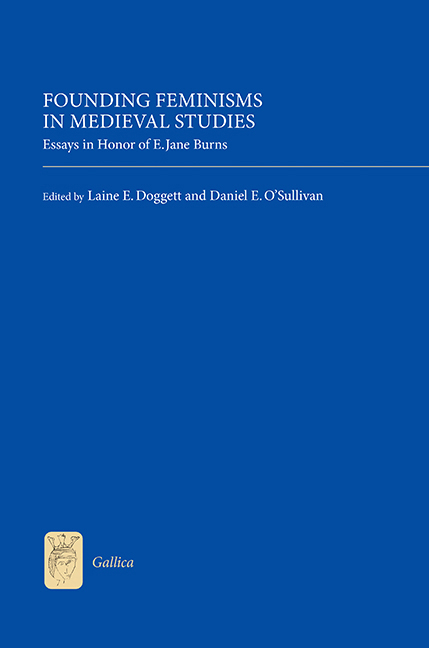Book contents
- Frontmatter
- Contents
- List of Illustrations
- List of Contributors
- Acknowledgements
- Introduction: The Work of E. Jane Burns and the Feminisms of Medieval Studies
- E. Jane Burns: A Bibliography
- Part I Debating Gender
- Part II Sartorial Bodies
- Part III Mapping Margins
- Women's Healing: From Binaries to a Nexus
- Silk in the Age of Marco Polo
- Another Land's End of Literature: Honorat Bovet and the Timbuktu Effect
- Part IV Female Authority: Networks and Influence
- Afterword: A Response to the Volume
- Index
- Tabula Gratulatoria
- Already Published
Another Land's End of Literature: Honorat Bovet and the Timbuktu Effect
from Part III - Mapping Margins
Published online by Cambridge University Press: 05 July 2016
- Frontmatter
- Contents
- List of Illustrations
- List of Contributors
- Acknowledgements
- Introduction: The Work of E. Jane Burns and the Feminisms of Medieval Studies
- E. Jane Burns: A Bibliography
- Part I Debating Gender
- Part II Sartorial Bodies
- Part III Mapping Margins
- Women's Healing: From Binaries to a Nexus
- Silk in the Age of Marco Polo
- Another Land's End of Literature: Honorat Bovet and the Timbuktu Effect
- Part IV Female Authority: Networks and Influence
- Afterword: A Response to the Volume
- Index
- Tabula Gratulatoria
- Already Published
Summary
Amid a line-up of intellectuals representing major traditions in pre-modern Europe, a Muslim figure stands out (fig. 1). The only man of color, “aussy noir comme charbon,” as black as coal, he steps out, dressed in a fur-line robe that displays his wealth and prestige. This portrait introduces a Saracen who takes his place with these men of science while he rivals them in all his difference. His authority is doubly challenging. Not only does his presence between a doctor and a Jew raise the Muslim question for intellectual life in late medieval Paris; but he does so at the center of the French Christian tradition.
Honorat Bovet, the author who created this Muslim figure, did so when the kingdom of France was at war, during a “tres perilleux temps, Nombre de XIIII cens ans, au dit commun de maint Crestiens, Juifs, Sarrazins et payens” [very perilous time, 1400, as is commonly said by many Christians, Jews, Saracens, and pagans]. Crusaders had been routed at Nicopolis, and bulletins of their humiliating enslavement sent back to Paris: the Christian world was braced against their adversaries in the East, the Ottoman Turks, for the first time. Bovet admits to his patron, Jean de Montaigu, the dread this situation inspires: “jay paour … et sy doubte que les Sarrazins durement ne griefvent Crestineté” [I fear and am apprehensive of the harm Saracens can inflict on the Christian world, l. 28–29, 60]. It is in this defeatist context, nonetheless, that Bovet invents an eloquent Saracen to ventriloquize a Muslim tradition menacing the French. Rather than keeping the enemy at bay, in a rare move, he entertains its representative. In the Apparicion Maistre Jean de Meun, Bovet designs a political debate that unfolds before Paris's most esteemed vernacular poet, is moderated by his fictive double, the Prior of Salon, and foregrounds the Saracen debater holding forth at great length. Bovet develops his voice strategically. He enlists it to report on the failings of the French, to reckon with their defeat, and to call urgently for reform. He even directs the Saracen's critique to those in power, delivering two manuscript copies of the Apparicion to the circle of Louis, Duke of Orléans, the king's brother.
- Type
- Chapter
- Information
- Founding Feminisms in Medieval StudiesEssays in Honor of E. Jane Burns, pp. 153 - 168Publisher: Boydell & BrewerPrint publication year: 2016

